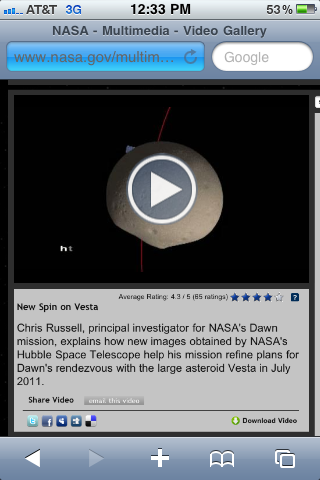We’re starting on the next go-round of what NASA.gov looks like and want to know what you think.
The digital universe has changed radically since we overhauled www.NASA.gov in 2007. When we released that version (NASA.gov 5.0) we were most concerned with reorganizing our content so that it reflects how the general public sees NASA and its work, making things easier for people to find. (Your feedback said we largely succeeded, though with a site as complex as NASA’s it will never be perfect.) We also added blogs and the ability for users to rate and comment on our content.
The biggest change since then has obviously been the growth of social media. You’ve probably seen some of the numbers: NASA has 1.3 million Facebook likes and 3.1 million Twitter followers, and more than 280,000 people circle us on Google+. I was wondering if that would mean a drop in visitors to the site as people became content with the information they could get on social media. In fact, visits to the site dropped from 2008 to 2009 and again from 2009 to 2010. Then we set a record with 150 million visits to the site in 2011 and already have 166 million this year. With four years of data, it’s now no surprise that they don’t correlate: while there’s some overlap between the two audiences, almost 70 percent of our site visitors aren’t really influenced by social media.
Meantime, we’ve been trying to bring the conversation back to NASA.gov. Social media sites are great for flashing the latest news or multimedia item around the world, but the depth and context are here on the site. We want to make sure people know that they can always learn more about what they’re most interested in by coming to the site.
We also want our regular visitors to know that there’s NASA content available off the site. We’ve embedded the @NASA Twitter feed in the home page so visitors can see the latest updates. We’re pushing streams of NASA TV to Ustream and videos to YouTube, and offering programming there that isn’t on NASA TV. We’ve covered recent news events by putting up a splash page that combines live NASA TV with Twitter feeds and active commenting.
Hand-in-hand with social media’s growth has been the public’s adoption of smartphones to access websites. We launched the mobile version of www.NASA.gov a couple of years ago and have watched its usage grow. We recently put it through some user testing and made some changes based on the results.
So — do you like something you’ve seen? Is something missing? How do you interact with NASA online? Where else do you get your NASA news from? We’re opening up an online forum at Ideascale to take your feedback. You can offer ideas of your own or comment and vote on others’ suggestions. You can post comments here. We’ll take all the data and do some prototyping, then see what you think.

